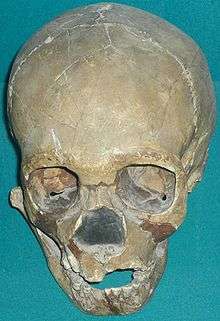Teshik-Tash
Teshik-Tash is an archaeological site in Uzbekistan in central Asia.
During the excavation in 1938 by A. P. Okladnikov in the Bajsuntau cave remains of a Neanderthal male child [1] were discovered in a shallow pit, reported as in association with five pairs of Ibex horns. Through dental analysis the skull was said to have been an 8-9 year old child. Fragments of several ibex ‘horn cores’ from Siberian mountain goats were also recovered from the cave. The horn cores were found around the perimeter of the grave surrounding the cranial remains. Researchers believe that the ibex horn cores suggest that the Teshik-Tash child was buried in a ritual manner.[2]
The site was excavated in five cultural layers of sediment. The skull was unearthed along with artifacts described as Mousterian tool assemblage.[3][4]
Lack of adequate published material on the excavation [5] and the numerous number of Ibex bones (761) found led to this interpretation being questioned. Paul Mellars, questioning the ritual interpretation suggested that the bones may not have been deliberately placed.[6]
The skull

The Teshik-Tash skull has an estimated age of 70 kya. Through carbon-14 (¹⁴C) dating, the date range of the skull is 130-45 kya, placing it in the Middle Paleolithic.[7]
Reconstruction
The Teshik-Tash skull was reconstructed from 150 bone fragments.[8] The skull was crushed due to the several layers of sediment that lay on top of it.
| in | cm | |
|---|---|---|
| Height | 7.75 | 19.69 |
| Width | 5.5 | 19.97 |
| Length | 6 | 15.24 |
Controversy
The Teshik-Tash skull’s dental analysis placed the age of the hominid between 8–9 years old at the time of death. The size of the skull was relatively larger than that of a modern child’s skull of the same age. Archaeologists suggested that this was because Neandertals have a faster rate of growth than modern Homo sapien adolescences. The skull is larger and taller and exhibited typical Neandertal traits such as an occipital bun, oval-shaped foramen magnum, shovel-shaped incisors, supraorbital ridge, and the absence of a strong chin.[8] Other midfacial features of the skull such as the lingual of the mandibular foramen were said to be more characteristic of modern humans than Neandertals. The morphological features of the Teshik-Tash skull lead researchers to question the classification as some argued that it was closer in morphological association with Upper Paleolithic Homo sapiens. Statistical analysis of 27 linear measurements placed the Teshik-Tash skull and mandible outside the variation of the Neandertals and associated it with Upper Paleolithic humans.[8]
DNA analysis
mtDNA analysis was conducted on the Teshik-Tash skull which confirmed that the skull was Neandertal. Further genetic research concluded that near-eastern Neandertals were somewhat segregated from northwestern European Neandertals and early Mediterranean Neandertals. This data is suggested through consistent low levels of gene flow between Neandertals and modern humans in the Near East.[8] The similarities of the Teshik-Tash skull and Upper Paleolithic Homo sapiens can be explained by analyzing the Skhul and Qafzeh specimens. The Skhul and Qafzeh fossils are Homo sapiens that exhibit some Neandertal features. This is because Neandertals were ancestral to modern humans in this region- therefore the fossils of the Skhul and Qafzen Homo sapiens are "intermediate" between Neandertals and current Homo sapiens sapiens.[8]
Significance
Prior to the discovery of the Teshik-Tash skull in 1938, it was thought that Neandertals had not spread east enough to reach Asia. The Neandertal population was known to be dense in Europe along the Mediterranean. The discovery of the Teshik-Tash skull extended the Neandertal range to Central Asia. It was the first Neandertal specimen discovered outside of the previous Neandertal range.[3]
See also
Notes
- ↑ Ash, Patricia J.; David J. Robinson (2010). The Emergence of Humans: An Exploration of the Evolutionary Timeline. Wiley. ISBN 978-0470013151.
- ↑ Teshik-Tash, Uzbekistan. Concise Oxford Dictionary of Archaeology, 01/2008, 2, ISBN 0199534047. Retrieved 2014-04-23.
- 1 2 New hominin remains from Uzbekistan. Journal of Human Evolution, ISSN 0047-2484, 2008, Volume 55, Issue 2, pp. 223 – 23. Retrieved 2014-04-23.
- ↑ Langer, William L., ed. (1972). An Encyclopedia of World History (5th ed.). Boston, MA: Houghton Mifflin Company. p. 9. ISBN 0-395-13592-3.
- ↑ Jurmain, Robert; Lynn Kilgore; Wenda Trevathan (2006). Essentials of Physical Anthropology. Wadsworth Publishing. p. 264. ISBN 978-0495030614.
- ↑ Winzeler, Robert L. (2007). Anthropology and Religion: What We Know, Think, and Question. Altamira Press. p. 51. ISBN 978-0759110465.
- ↑ Teshik-Tash. Cambridge Dictionary of Human Biology and Evolution, 2005, ISBN 9780521662505. Retrieved 2014-04-23.
- 1 2 3 4 5 The Mousterian child from Teshik-Tash is a Neanderthal: a geometric morphometric study of the frontal bone. American Journal of Physical Anthropology, ISSN 0002-9483, 11/2012, Volume 149, Issue 3, pp. 365 – 379. Retrieved 2014-04-23.
Coordinates: 37°57′57″N 67°09′23″E / 37.96583°N 67.15639°E